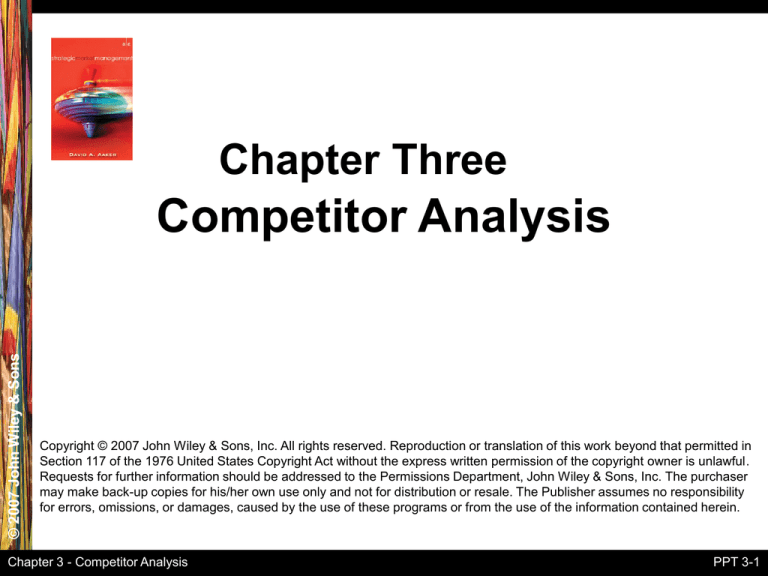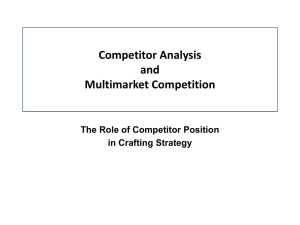
Chapter Three
© 2007 John Wiley & Sons
Competitor Analysis
Copyright © 2007 John Wiley & Sons, Inc. All rights reserved. Reproduction or translation of this work beyond that permitted in
Section 117 of the 1976 United States Copyright Act without the express written permission of the copyright owner is unlawful.
Requests for further information should be addressed to the Permissions Department, John Wiley & Sons, Inc. The purchaser
may make back-up copies for his/her own use only and not for distribution or resale. The Publisher assumes no responsibility
for errors, omissions, or damages, caused by the use of these programs or from the use of the information contained herein.
Chapter 3 - Competitor Analysis
PPT 3-1
Competitor Identification
© 2007 John Wiley & Sons
Customer-Based Approaches
– Customer choices – What brand would you buy if
your favorite was unavailable?
– Application associations – What applications?
What brands for each application?
– What product substitutes?
Chapter 3 - Competitor Analysis
PPT 3-2
Competitor Identification
© 2007 John Wiley & Sons
Strategic Groups
– Pursue similar competitive strategies
– Have similar characteristics
– Have similar assets and competencies
Chapter 3 - Competitor Analysis
PPT 3-3
Competitor Analysis
Potential Competitors
– Market expansion
– Product expansion
© 2007 John Wiley & Sons
– Backward integration
– Forward integration
– Export assets or competencies
– Retaliatory or defensive strategies
Chapter 3 - Competitor Analysis
PPT 3-4
Understanding the Competitors
© 2007 John Wiley & Sons
Size, Growth
& Profitability
Strengths and
Weaknesses
Image and
Positioning
Competitor
Actions
Exit Barriers
Chapter 3 - Competitor Analysis
Objectives and
Commitment
Current and
Past Strategies
Organization
and Culture
Cost Structure
Figure 3.3
PPT 3-5
Identify Assets and Competencies
1) What businesses have been successful over
time?
© 2007 John Wiley & Sons
What assets or competencies contributed
to their success?
What businesses have had chronically low
performance?
Why?
What assets or competencies do they lack?
Chapter 3 - Competitor Analysis
PPT 3-6
Relevant Assets and Competencies
© 2007 John Wiley & Sons
2) What are the key customer motivations?
What is really important to the customer?
3) What are the large mobility barriers (both
entry and exit)?
Chapter 3 - Competitor Analysis
PPT 3-7
Relevant Assets and Competencies
Consider the components of the value chain.
Do any provide the potential to generate a
competitive advantage?
© 2007 John Wiley & Sons
4)
Chapter 3 - Competitor Analysis
PPT 3-8
© 2007 John Wiley & Sons
Support Activities
The Value Chain
Firm Infrastructure
Human Resource Management
Technology Development
Procurement
Inbound
Outbound
Operations
Logistics
Logistics
Chapter 3 - Competitor Analysis
Marketing
&
Sales
Service
Primary Activities
Source: Reprinted with permission ã 1985 Michael Porter
PPT 3-9
© 2007 John Wiley & Sons
Key Learnings
•
Competitors can be identified by customer choice (the set from which customers
select) or by clustering them into strategic groups, (firms that pursue similar
strategies and have similar assets, competencies, and other characteristics). In
either case, competitors will vary in terms of how intensely they compete.
•
Competitors should be analyzed along several dimensions, including their size,
growth and profitability, image, objectives, business strategies, organizational
culture, cost structure, exit barriers, and strengths and weaknesses.
•
Potential strengths and weaknesses can be identified by considering the
characteristics of successful and unsuccessful businesses, key customer
motivations, and value-added components.
•
The competitive strength grid, which arrays competitors or strategic groups on
each of the relevant assets and competencies, provides a compact summary of
key strategic information.
Chapter 3 - Competitor Analysis
PPT 3-10
© 2007 John Wiley & Sons
Ancillary Slides
Chapter 3 - Competitor Analysis
PPT 3-12
© 2007 John Wiley & Sons
“Induce your competitors not to
invest in those products, markets
and services where you expect to
invest the most… that is the
fundamental role of strategy.”
Chapter 3 - Competitor Analysis
- Bruce Henderson
Founder of BCG
PPT 3-13
“There is nothing more
exhilarating than to be shot at
without result.”
© 2007 John Wiley & Sons
- Winston Churchill
Chapter 3 - Competitor Analysis
PPT 3-14
“The best and fastest way to learn
a sport is to watch and imitate a
champion.”
© 2007 John Wiley & Sons
- Jean-Claude Killy,
Skier
Chapter 3 - Competitor Analysis
PPT 3-15
“There is one rule for industrialists
and that is: Make the best quality of
goods possible at the lowest cost
possible, paying the highest wages
possible.”
© 2007 John Wiley & Sons
- Henry Ford
Chapter 3 - Competitor Analysis
PPT 3-16
“We often give our enemies the
means for our own destruction.”
© 2007 John Wiley & Sons
- Aesop
Chapter 3 - Competitor Analysis
PPT 3-17
“In business, the competition will
bite you if you keep running, if you
stand still, they will swallow you.”
© 2007 John Wiley & Sons
- William Knudsen
Chapter 3 - Competitor Analysis
PPT 3-18









